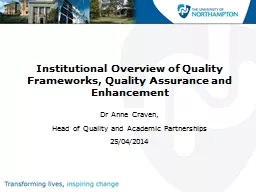

Dr Anne Craven Head of Quality and Academic Partnerships 25042014 Northampton Quality Assurance Framework NQAF Core Quality Assurance Processes Assuring standards use of data Planning and Development Approval ID: 661484
Download Presentation The PPT/PDF document "Institutional Overview of Quality Framew..." is the property of its rightful owner. Permission is granted to download and print the materials on this web site for personal, non-commercial use only, and to display it on your personal computer provided you do not modify the materials and that you retain all copyright notices contained in the materials. By downloading content from our website, you accept the terms of this agreement.
Slide1
Institutional Overview of Quality Frameworks, Quality Assurance and Enhancement
Dr Anne Craven,
Head of Quality and Academic Partnerships
25/04/2014Slide2
Northampton Quality Assurance Framework (NQAF)Slide3
Core Quality Assurance Processes
Assuring standards; use of data
Planning and Development Approval
Validation
Monitoring and Evaluation
School Quality, Standards and Enhancement Committee
Boards of Studies
Annual Review
Modules and Subjects
School
Institution: Standards; Learning Opportunities
Change of Approval
Periodic Subject Review
External Scrutiny (External Examiners/PSRBs)Slide4
Core Quality Enhancement Processes
Enhancing quality of learning opportunities
Enhancement as strategic appreciation and spreading of good practice and continuous improvement across the institution
Linked to quality assurance
self-reflection
Peer advice
Sharing of good practice
Listening to students/student voice
Use of data
External advice and comment/QAA; communities of practice
External Examiners
Approval, monitoring and review of programmes
School Quality, Standards and Enhancement Committee and UN CommitteesSlide5
Slide6
University Modular Framework (UMF)
A flexible framework which allows students to study full-time, part-time, or as a distance learner
Continuous; covers all modules from level 4 to level 8
E
nsures that students have an equitable educational experience irrespective of their programme of studies.
Designed to consider learning as a continuum.
A common set of progression and assessment regulations
Governs the design process for modules and their organisation into a range of awards.
A student centred learning experience enabling individual progression, development and achievementSlide7
University Modular Framework (UMF)
Modular structure – 10, 20, 40 (etc.) credits
Credits forming an approved programme of study (APS)
A named degree formed according to Award Map
Compulsory and Designated Modules; Electives
FT Undergraduate: 120 (100) credits/year (max. 140)
Changing and withdrawing from modules governed by regulations
Attendance and Cause for Concern policySlide8
University Modular Framework (UMF)
Course design, Validation and Change of Approval done to a certain timetable within the academic year
Course documentation (module specifications, module catalogue; also
prog
. specifications incl. key skills maps)
Distinctiveness of degrees and pathways; similarity and difference defined by percentages
Degree names (BSc, BA, etc.; joint degrees ‘with’ or ‘and’)
Awards/Exit awards (e.g. Honours degree/Ordinary degree); Combined StudiesSlide9
University Modular Framework (UMF)
AwardsSlide10
University Modular Framework (UMF)
Period of registration Slide11
University Modular Framework (UMF)
Levelness and Learning Outcomes; linked
to assessmentSlide12
University Modular Framework (UMF)
Study Hours Slide13
University Modular Framework (UMF)
‘Skills Agenda’
Key Skills Map
EmployabilitySlide14
University Modular Framework (UMF)
Designing Assessment Slide15
University Modular Framework (UMF)
Assessments specified in the course documentation (Validation); details in the annual Modules Guides
2 attempts (Extensions; deferrals;
m
itigating circumstances; referral; re-start)
Late submissions/failures of submission affecting mark
Assessment from A+ to F-; G a non-submission mark
Failing students may re-sit during the year
Accumulated failure:
and failed, having exhausted all opportunities for re-assessment
. Either: more
than 80 credits at level four,
or
more than 60 credits at level
five, or
more than 80 credits at level
six, or
more than 40 credits at level
seven, or
20 credits at level
eight. Each
failure
contributes
to this count
.
Condonement
: At levels 4 and 5 only, a student who successfully passes modules amounting to 100 credits and has an F+ in one or two modules amounting to no more than 20 credits in total will be awarded a condoned fail, recorded as grade E.Slide16
University Modular Framework (UMF)
Marking: PGSlide17
University Modular Framework (UMF)
Marking: UGSlide18
University Modular Framework (UMF)
Grading Slide19
University Modular Framework (UMF)
UG Classification (degrees)
Ordin
. degrees not classified
Others Distinct./Merit/PassSlide20
Classification – Masters and PG Dip (PG Cert, Grad Cert/
Dipl
not classified)